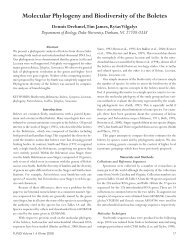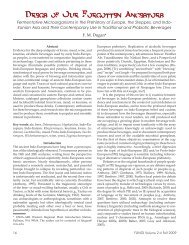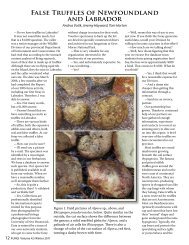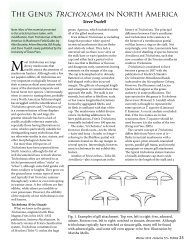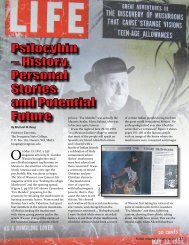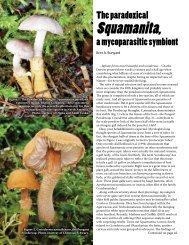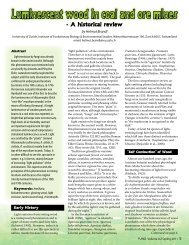Notes from Under- ground - FUNGI Magazine
Notes from Under- ground - FUNGI Magazine
Notes from Under- ground - FUNGI Magazine
Create successful ePaper yourself
Turn your PDF publications into a flip-book with our unique Google optimized e-Paper software.
these are the French brothers Louis René Tulasne (1815–1885)<br />
and Charles Tulasne (1816–1884), best known for first postulating<br />
the pleomorphic nature of the fungi in Selecta Fungorum<br />
Carpologia (1861–1865). Charles Tulasne’s illustrations in this, their<br />
magnum opus, a total of 61 uncolored plates, stand as a magnificent<br />
example of pictorial surrealism, regardless that their manifest<br />
content is the minute depiction of the erysiphales (powdery<br />
mildews) and pyrenomycetes as seen through a microscope. What<br />
makes the Tulasne illustrations surreal? Does it even make sense<br />
to apply this term to scientific illustration? One example will suffice:<br />
the plate depicting Phyllactinia guttata, the cleistothecium<br />
(fruiting body) of which bears a series of radiating appendages<br />
and a mucilage-secreting crown. The fungus is a powdery mildew<br />
that parasitizes common trees. Charles Tulasne’s illustration shows<br />
a field of energized cleistothecia febrile with life, multiplying,<br />
sporulating, lifting off like alien ships, and brandishing spiny points<br />
in great agitation. One cleistothecium under greater magnification<br />
bursts with phalloid asci <strong>from</strong> under a foaming thicket of<br />
mucilage that literally spurts multiplex appendages. Here is the<br />
convulsive beauty that Andre Breton had claimed as an aesthetic<br />
paradigm: the lyricism of the subvisible rendered visible, unearthly<br />
but of the earth, and while not exactly an internal model externalized,<br />
an external model (the fungus itself) utterly unconventional,<br />
dangerous as a potent vector of plant disease yet outside<br />
normal awareness and perception. For mycologists only? Perhaps.<br />
But what Tulasne had done is pictured the unknown, nature’s<br />
imagination, <strong>from</strong> a plane of reality dripping with the hallucinatory<br />
décor of advancing mycelial threads that propagate, threaten,<br />
and control. Never mind the paeans of praise to the Good Lord<br />
that these righteous mycologists, the Tulasne brothers, have fixed<br />
firmly in the preface to the Selecta, for in these illustrations they<br />
have undermined the great chain of being and all that it symbolized<br />
as a Christian hierarchy by asserting the omnipotence of the<br />
fungus. As a surrealist subject, Tulasne’s Phyllactinia guttata far<br />
surpasses Salvador Dalí’s tedious iconography of common objects<br />
that liquefy and melt, and he explores much wilder terrain than<br />
Grandville or even Odilon Redon. His worthy successor is the<br />
surrealist Yves Tanguy, whose milky landscapes erupted incrementally<br />
with indistinct fungal nodules climaxing in his last great painting,<br />
Multiplication of the Arcs (1954), a riot of fungal formations<br />
turned to frozen stone. It is quite surprising that Breton and company<br />
never claimed Charles Tulasne as one of their own. 29 As it<br />
requires no great exertion of imagination to find an arcyria or<br />
cordyceps lurking in the artwork of Joan Miró (e.g., Le Jardin de<br />
Mousse, 1968), so too it makes sense, analogically, to validate the<br />
surreal potential in the mycological illustrations of Charles Tulasne.<br />
Many other examples may be gleaned <strong>from</strong> surrealism’s history.<br />
The Czech surrealist Toyen, for example, painted mushrooms<br />
directly <strong>from</strong> experience. In her painting Chateau Lacoste (1946),<br />
Toyen: Chateau Lacoste, 1946.<br />
Toyen depicts a cluster of olivaceous fungi emerging <strong>from</strong> cracks<br />
in a wall near the sketched outline of a fox whose foot is strangling<br />
a blue bird at the wall’s base. The caespitose fungi contribute<br />
significantly to the menacing atmosphere. A case could be<br />
made for fungal manifestations in the wraith-like paintings of<br />
Wolfgang Paalen, whose lifework blended surrealist with scientific<br />
and anthropological perspectives. 30 The culmination of this<br />
hybrid sensibility (surrealism and science) appears in the work of<br />
Jean Painlevé (1902–1989), an idiosyncratic French filmmaker<br />
who directed over two hundred science and nature films and whose<br />
credo was “science is fiction.” Aligned with the surrealists for a<br />
time and scandalizing the scientific community with an avantgardist’s<br />
propensity to shock, Painlevé pioneered underwater<br />
photography and lovingly befriended octopi and crustaceans in<br />
his perfervid pursuit to reveal their human qualities in cinema.<br />
Among many notable films were Hyas and Stenorhynchus (1929),<br />
depicting crabs in seaweed camouflage; Freshwater Assassins (1947),<br />
which explored “forms of alimentary destruction” with a jazzy<br />
soundtrack by Louis Armstrong; Love Life of the Octopus (1965), on<br />
the mechanics of sex among the cephalopods; and Acera or The<br />
Witches’ Dance (1972) in which acera mollusks whirl like flying<br />
mushrooms. At the close of World War II, Painlevé revived the<br />
Institute of Scientific Cinema in Paris, whose film conference in<br />
1946 screened over three dozen science films including Predatory<br />
Mushrooms and Insects in Vegetables. Painlevé relentlessly sought to<br />
make the familiar alien and the alien familiar by upending traditional<br />
categories of human and animal in his painstaking documentaries.<br />
In this, he was also a friend of the fungi and claimed<br />
his affection in a surrealist tract “Neo-Zoological Drama” (1924)<br />
that begins: “The plasmodium of the Myxomycetes is so sweet.”<br />
His taxonomic principles were exacting but crazy, that is to say,<br />
surreal: just as Georges Buffon postulated that truffles were an<br />
intermediate stage between stones and mushrooms, and Andre<br />
Breton ridiculed the idea of three kingdoms as the “height of absurdity,”<br />
so too Painlevé insisted, “To me there is no difference between<br />
minerals, vegetables, and animals. They are all linked<br />
through evolution.” As a cinematographer of nature, Jean Painlevé<br />
28 <strong>FUNGI</strong> Volume 2:1 Spring 2009



